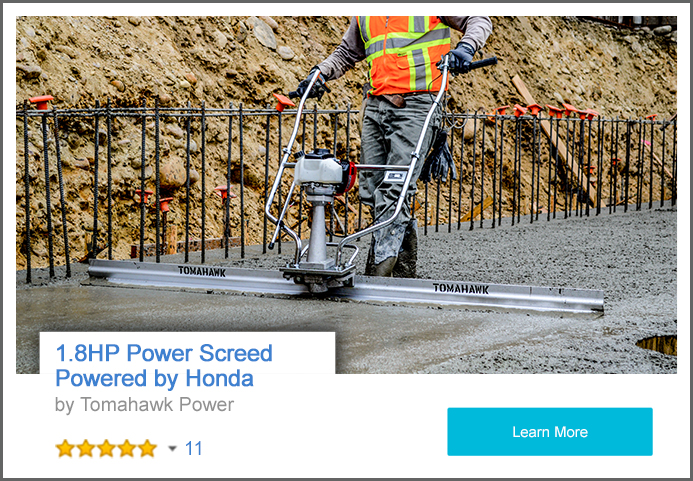The tilt up concrete construction has been an economical option for contractors throughout the Dallas/Fort Worth market for years. Tomahawk Power construction products like our power screeds, generators, concrete sprayers, concrete vibrators, and compaction equipment are all utilized for this type of specialty concrete project. But what is tilt up concrete construction? How are products like power screeds, generators, concrete sprayers, concrete vibrators, and compaction equipment used, and when? Keep reading for a list of common steps during the tilt up concrete construction process.
Prepare the Tilt-Up Panel Forms
Before contractors can even begin to build the concrete panels, they first have to pour a flat slab of concrete that they can work off of. Often times this concrete slab is temporary, but depending on the job they may keep it in place. Compaction equipment such as forward plate compactors and rammers are utilized to help prepare the surface to ensure the soil and foundation are compact, concrete vibrators may be used to eliminate air pockets as the contractor pours the temporary slab, and power screeds and trowels are utilized to smooth out the surface of the concrete.
All of this preparation is critical to ensure that the panels that will be poured next are built on a flat surface. Before a concrete contractor can pour the first panel, they need to frame the tilt up panel per the job specification and mark the dimensions of the pour on the temporary concrete slab. Contractors build the tilt-up panel forms out of wood and fasten them with braces. Rebar and embeds/inserts need to be placed to during this part of the process, and corded power tools are often utilized. Generators help bring the power to the jobsite for corded tools. Ranging from 2000-9000 watts, generators are ideal for tools or trailers on remote jobsites that require onsite power.
Pouring the Concrete Panels
After laying rebar and forming the tilt up panels, it’s time to pour the tilt up concrete slab! As the tilt up panel is being poured, it is critical to utilize concrete vibrators to eliminate air pockets and ensure a strong enough concrete panel to meet the job specification. Power screeds and power trowels are used to smooth out the concrete pour that fills the panels that were framed in step 1. After the concrete slab is smoothed out, concrete cure is often sprayed per job specification. Spraying a concrete curing compound prevents the concrete from drying out too quickly, and adds to the overall quality and lifespan of the concrete panel. Tomahawk offers the only gas powered backpack concrete sprayer on the market. It ranges from 50-435 PSI, and is perfect for spraying concrete curing compounds, among a variety of other concrete finishing applications.
Standing the Concrete Panels
Now that the concrete panel is set and the concrete has hardened to the correct PSI level per the job specification, it’s time to finally “tilt-up” the concrete panel. Cranes are utilized in this part of the process to lift the panel up into the predesignated location on the jobsite, and brackets are fastened to keep the panels in place throughout the duration of the construction process.
Modern tilt-up construction is a technique that has been practiced in the United States since the early 1900s. It has been used to create some of the largest warehousing, manufacturing, and industrial parks in the world, including the largest tilt-up construction project in history for Daikin Industries, Ltd. In Houston, TX. This project involved a 4 million square foot concrete panel building - just imagine how many rammers, plate compactors, concrete sprayers, concrete vibrators, power screeds, and power trowels they needed for that job!











